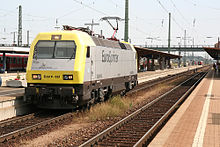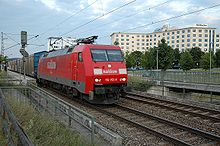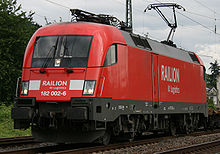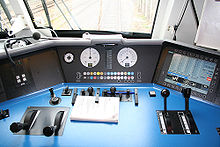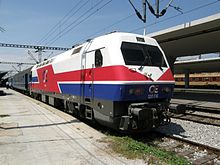- EuroSprinter
-
Eurosprinter 
ÖBB Class 1016 (ES 64 U) with EuroCity train Power type Electric Builder Krauss-Maffei, Siemens Model ES 64 F *
ES 64 F4 **
ES 64 U ***Build date 1996–2001 *
2003– **
2000– ***Total produced 170 *
100+ **
360+ ***UIC classification Bo'Bo' Gauge 1,435 mm (4 ft 8 1⁄2 in) Length 19.58 m (64 ft 3 in) Locomotive weight 86–87 tonnes Traction motors Four Top speed 140 km/h (87 mph) */**
230 km/h (140 mph) ***Power output 6,400 kW (8,600 hp) Tractive effort 300 kN (67,000 lbf) Locomotive brakes Air and electric Train brakes Air Safety systems Sifa, PZB, ETCS, various The EuroSprinter family of electric locomotives is a modular concept of locomotives for the European market built by Siemens. The internal Siemens product name is ES 64, with ES for EuroSprinter and the number 64 indicating the 6,400 kW power at rail.
Additional information is given in the name on the usage (U as universal, P as prototype and F as freight) and on the number of electric power systems supported (e. g. 2 as two types, 4 as all four commonly used systems in Europe).
Contents
Development
The first prototype ES 64 P was built in 1992, as Deutsche Bahn AG was expected to issue a large order of locomotives as a replacement for the ageing Einheits-Elektrolokomotiven. The external appearance was similar to the earlier Siemens/Krauss-Maffei made dual voltage Spanish RENFE Class 252, delivered in 1991, which in turn used three phase asynchronous drive technology introduced with the DB Class 120.[1][2] The prototype was used for extensive tests in some countries in Europe (Norway, Spain, Portugal, Germany)[citation needed]. The prototype was given the DB reporting name Class 127. It is still in service with Dispolok[citation needed], a formerly Siemens-owned locomotive pool for on-hire use.
Standard types
ES 64 F
The ES 64 F is an electric freight locomotive with 6,400 kW power and a top speed of 140 km/h. Though it is equipped for passenger services, it is exclusively used for freight trains. It was introduced to Deutsche Bahn AG as Class 152 in 1996 and today is operated by DB Schenker Rail. Its main role is to replace the older Class 150 and Class 151 locomotives on heavy freight trains. The original German order of 195 units was reduced to 170, as the ÖBB feared that the axle hung traction motors would damage the tracks on the country's mountain railway lines[vague]. Instead, DB AG ordered the remaining 25 ES 64 U2.
With Class 152 DB AG abandoned the CoCo wheel arrangement of the class 150 and 151; with the new digitally controlled anti wheel-slip control the tractive effort should be brought to bear more reliably: nonetheless, some engine drivers argue that in autumn, due to slippery tracks, heavy trains are hard to accelerate. Maximum speed excluded, all performance characteristics are similar to those of DB AG class 101.
ES 64 F4
The ES 64 F4 is an electric freight locomotive with 6,400 kW power and a top speed of 140 km/h, in Germany the reporting name is Class 189. It is also equipped for passenger service, but seldom used in that role. ES 64 F4 is equipped for all four electric systems commonly used in Europe (15 and 25 kV AC, 1.5 and 3 kV DC). Because limited space inhibits installation of all safety systems, Class 189 is equipped with various packages giving partial European coverage, e. g. Germany and Switzerland. The braking system includes an electrical energy recovery system.
As well as being in service with Deutsche Bahn AG as Class 189, it is also utilised by SBB as Class RE 474. Some units are available to let from the Dispolok locomotive pool.
ES 64 U
Based on the Eurosprinter concept the ES 64 U was developed as a universal electric locomotive with a top speed of 230 km/h. The series ES 64 U is only capable of operating on the 15 kV (16.7 Hz) supply. It is in service in Austria with ÖBB as Class 1016. Unlike the F series, all U series are equipped with quill drive instead, thus reducing the track forces.[3] The ÖBB assigned the protected name Taurus to Class 1016 (and later to the Classes 1116 and 1216); since then all ES 64 U+ series are widely known in as 'Taurus' locos.
The ES 64 U2 can also operate on 25 kV, 50 Hz AC. It is operated by ÖBB as Class 1116, by Deutsche Bahn AG as Class 182 and as well as by MÁV and as a hire locomotive from dispolok. Both MÁV and the Hungarian-Austrian company GySEV (Gyõr-Sopron-Ebenfurth Railway Corp) operate these units as Class 1047.
All four European electric systems can be used by the ES 64 U4. Its electric components are mostly identical to those of ES 64 F4. The four-system series (with the 1500 V capability disabled within the software) are currently used in Austria by ÖBB and the private operator Rail Traction Service as Class 1216, in Slovenia by Slovenske železnice (SZ) as Class 541 and in Poland by Polskie Koleje Państwowe (PKP) as Class EU44 "Husarz". In Italy RFI assigns the classification E 190.
The minor changes in the layout of this type means that it is the third generation of the Eurosprinter family.
A special version of the ES 64 U4 was delivered to the Vogtlandbahn of Germany with the designation Class 183. Although the body is the same as any other ES 64 U4 locomotive, it is dual supply and can only operate on the German 15kV, 16.7 Hz AC and the Czech 25kV, 50 Hz AC systems. This also reveals the first inconsistencies in the type designations, as it should be called a ES 64 U2, while Siemens only adopts the ES 64 U4 designation for this version; it is rumoured that the Vogtlandbahn locomotives do have the equipment to operate on all 4 systems (which could explain why Siemens remains with the ES 64 U4 designation), but that the different software used in this subseries and the lack of 2 extra pantographs prevents them from doing so.
On 2 September 2006 the locomotive 1216 050-5 (prior to delivery to ÖBB) set a new world record for conventional electric locomotives, during the trials near Nürnberg it reached a top speed of 357 km/h.[4] Remarkably enough, the locomotive was not modified for the record.
Derived types
Danish Class EG
For the newly built crossing of the Danish straits (Great Belt Fixed Link) the Danske Statsbaner ordered 13 units of the Class EG which were delivered from 1999 to 2000. Based on the Eurosprinter concept, the wheel arrangement was modified to Co'Co' in order to ensure maximum tractive effort on the ramps. The tractive effort with this class is 400 kN (90,000 lbf) instead the usual 300 kN (67,000 lbf), with an overall length of 20.95 m (68 ft 9 in). This type is closest in design to a second generation ES 64 F2, capable of operating under 15 kV and 25 kV AC. [5]
Greek Class 120
Main article: OSE class 120The Greek OSE Class 120 is their first electric locomotives in service. From 1996 to 2001 a total of 30 class 120 were delivered to Greece. The concept is mostly identical the ES 64 P prototype, with changes to the power (5,000 kW/6,700 hp) and the electric system (25 kV AC).
China Railways DJ1
Main article: China Railways DJ1In 1997, the Chinese Ministry of Railways ordered 20 units of type DJ1 freight locomotives from a joint venture formed by Siemens and Zhuzhou Electric Locomotive Works. Part of the locomotives design is based on second generation of EuroSprinter platform. Each 8 axle 2(Bo'Bo') locomotive consists of two coupled single cab 4 axle units.
China Railways HXD1
Main article: China Railways HXD1Initially named DJ4, successor of the DJ1, with more powerful traction motors, higher traction effort and IGBT traction inverters these locomotives were also intended for the Daqin Railway.
China Railways HXD1B
On August 18, 2007, Siemens and Zhuzhou won a contract from Ministry of Railways to build 500 Co'Co' EuroSprinter-based locomotives, at the time of production the locomotives are amongst the most powerful in the world in commercial production with a power of 9.6MW.[6]
Korail 8100, 8200
Main article: Korail Class 8200Since 2000, Korail has continuously built ES64Fs to replace older class 8000 ELs. The Korail 8000 class electric locomotives are powerful but too slow (85 km/h maximum) to operate for general passenger train. Currently, 85 ES64F variants are built (2 of Class 8100 and 83 of Class 8200).
These new 8100s and 8200s are operating on major Korail lines, including Gyeongbu, Honam, and Jungang Line.
Cities Sprinter
Main article: Amtrak Cities SprinterThe Cities Sprinter design is based on the EuroSprinter, but with substantial modifications including crumple zones and an improved safety cage for the driver.[7]
Developments
Main article: Vectron (locomotive)In 2010 Siemens announced a successor design, named 'Vectron' incorporating design features of both the Eurosprinter, and Eurorunner locomotives, initially available only in an electric version. The Eurosprinter design is to be continued to be offered by Siemens as well in the short term.[8]
See also
- Contemporaries and potential competitors in the European electric locomotive market:
- Bombardier TRAXX
- Alstom Prima locomotives
- 'Lok 2000' family of locomotives produced by ABB/Adtranz for Swiss (SBB-CFF-FFS Re 460), Norwegian (NSB El 18) and Finnish Railways (VR Class Sr2)
- Contemporary Siemens locomotive products
- Siemens Eurorunner
- Siemens Asiarunner
- Amtrak ACS-64
References
- ^ Renfe S/252: Introduction www.railcolor.net
- ^ EuroSprinter 1st generation www.railcolor.net
- ^ The modern wheelset drive system and possibilities of modelling with torsion dynamics. Michael Lata. (introduction explains the referenced principle)
- ^ Siemens File on Record Run
- ^ http://www.siemens.cz/extra/msv/cd/TS/Vozidla/Loko_EG_3100_2_Denmark_EN.pdf
- ^ Siemens wins locomotive order worth over 334 million euros Siemens.com
- ^ "Railway Gazette: Amtrak orders Siemens 200 km/h Cities Sprinter locomotives". http://www.railwaygazette.com/nc/news/single-view/view/amtrak-orders-siemens-200-kmh-cities-sprinter-locomotives.html. Retrieved 2010-10-30.
- ^ The Vectron – Siemens’ new generation of locomotives for rail transportation in Europe Press release , 29/6/2010 , www.siemens.com
External links
- Siemens Transportation Website
- Drehstromloks.de - A comprehensive site about EuroSprinter and other Neubaulok series (German)
- Railcolor.net - Another comprehensive site about EuroSprinter and other Neubaulok series
- Specification Sheet for the ES64U2
Sources
- Karl Gerhard Baur: TAURUS - Lokomotiven für Europa. Eisenbahn-Kurier-Verlag, Freiburg 2003. ISBN 3-88255-182-8
- Bo Oldrup Pedersen, Ole Aaboe Jörgensen, Günther Pröll: Co'Co'-Zweifrequenzlokomotive EG 3100 für Danske Statsbaner. Oldenbourg, München ????.
- Markus Inderst: Europalok auf Rampenstrecken. Neue DB-Baureihe 189. In: LOK MAGAZIN. GeraNova Zeitschriftenverlag GmbH, München Nr. 255/Jahrgang 41/2002, S. 28. ISSN 0458-1822
- Konrad Koschinski: Taurus & Hercules - DB-182, ÖBB-1016/1116, MAV-1047.0, GySEV-1047.5, Siemens-Dispolok, ÖBB-2016. Sonderausgabe. Eisenbahn Journal. Merker, Fürstenfeldbruck 2003,1. ISSN 0720-051x
Rolling stock of Austria Locomotives DieselÖBB Class 2016 · ÖBB Class 2048 · ÖBB Class 2070ElectricÖBB Class 1016 (Taurus) · ÖBB Class 1018 · ÖBB Class 1043 · ÖBB Class 1089 (crocodile) · ÖBB Class 1116 (Taurus) · ÖBB Class 1189 (crocodile) · ÖBB Class 1216 (Taurus)High speed trains Multiple units DieselÖBB Class 5022 · ÖBB Class 5047ElectricÖBB Class 4011 · ÖBB Class 4020 · ÖBB Class 4023 (Talent) · ÖBB Class 4024 (Talent) · ÖBB Class 4030 · ÖBB Class 4124 (Talent)See also Category:Rolling stock of Austria, ÖBB rolling stock and Rail transport in AustriaElectricDSB class EA · DSB Class EG (Eurosprinter)SteamDSB class A · DSB class B · DSB class D · DSB class E · DSB class F · DSB class G · DSB class H · DSB class K · DSB class N · DSB class P · DSB class PR · DSB class Q · DSB class R · DSB class S · DSB class THigh speed trains Intercity Express (Copenhagen service)Multiple units DieselAlstom Coradia LINT · IC3 · IC4 · DSB class MA · DSB class MA 1-3 · DSB class MB · DSB class MBF · DSB class MC 21-22 · DSB class MC 651-655 · DSB class MDF · DSB class ME 31-47 · DSB class MF · DSB class MK-FK · DSB class ML · DSB class ML 84-99 · DSB class MO · DSB class MP · DSB class MP-FP · DSB class MQ · DSB class MQ 207-210 · DSB class MR · DSB class MR 201-206 · DSB class MS · Siemens DesiroElectricIR4 · ØresundstogRailbuses MaK GDTsee also Category:Rolling stock of Denmark , List of DSB locomotives and multiple units and Rail transport in DenmarkClasses of German electric locomotives Current class numbering 101 · 103 · 104 · 109 · 110 · 111 · 112 · 112 (old) · 113 · 114 · 114 (old) · 115 · 116 · 117 · 118 · 119 · 120 · 127 · 128 · 132 · 139 · 140 · 141 · 142 · 143 · 144 · 145 · 146 · 146.1 · 146.2 · 150 · 151 · 152 · 152 (DB) · 155 · 156 · 160 · 163 · 169 · 171 · 175 · 180 · 181 · 182 · 182 alt · 183 · 183 alt · 184 · 185 · 186 · 188 · 189 · 190 · 191 · 193 · 193 (old) · 194
Pre-1968 class numbering DR classes Older DR classes see also Category:Deutsche Bundesbahn locomotives , Category:Deutsche Reichsbahn (East Germany) locomotives , Category:Deutsche Bahn locomotivesCategories:- Bo-Bo locomotives
- Siemens locomotives
- DSB (railway company) locomotives
- 15 kV AC locomotives
- 25 kV AC locomotives
- 1500 V DC locomotives
- 3000V DC locomotives
- Electric locomotives of Austria
- Electric locomotives of the People's Republic of China
- Electric locomotives of Denmark
- Electric locomotives of Germany
- Electric locomotives of South Korea
- Railway locomotives introduced in 1996
- Contemporaries and potential competitors in the European electric locomotive market:
Wikimedia Foundation. 2010.

